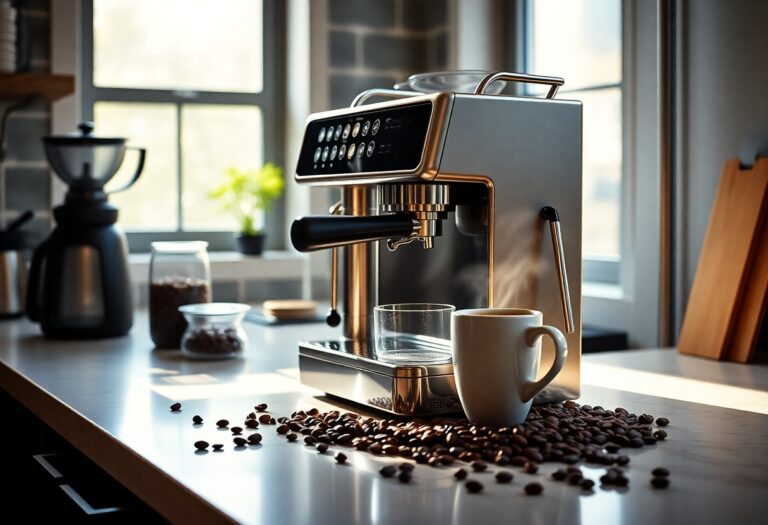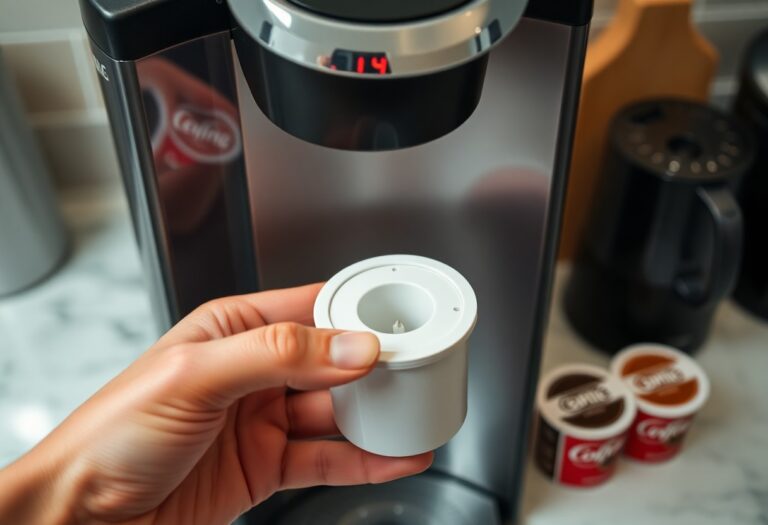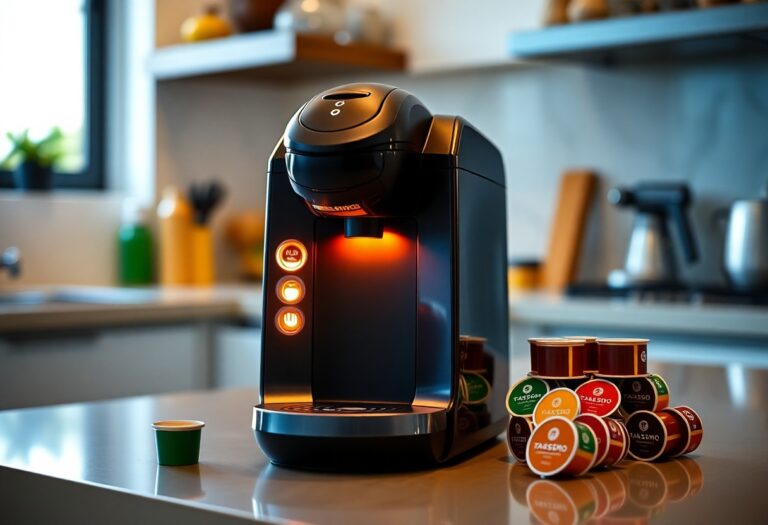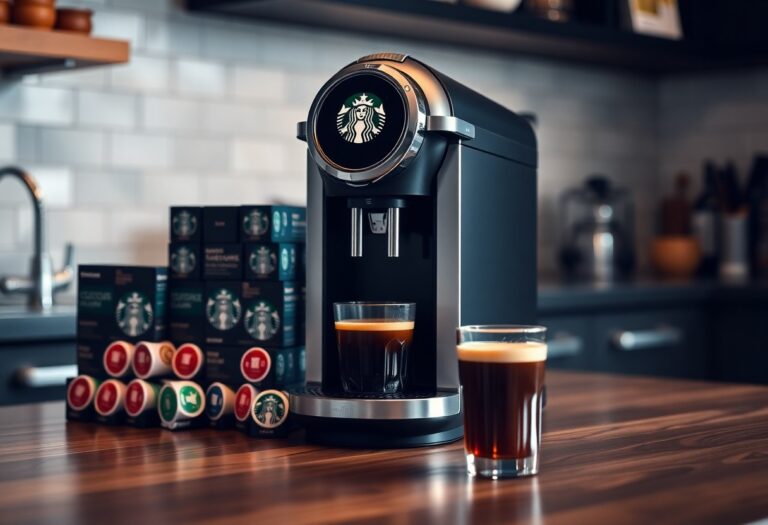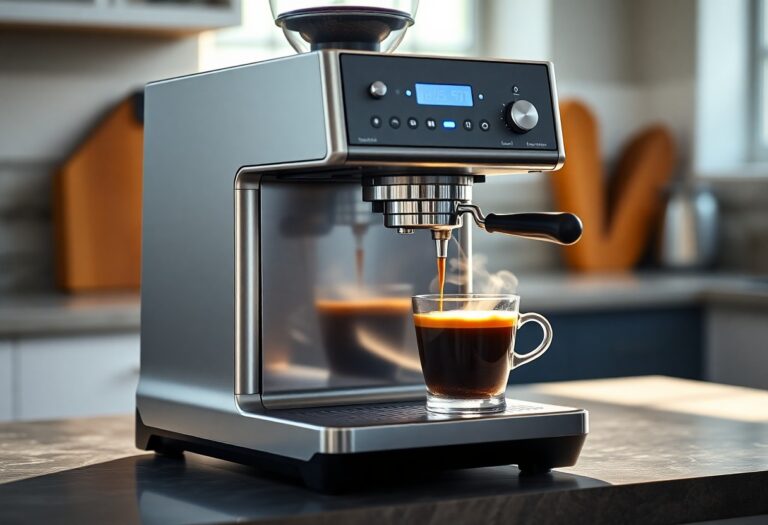What Machine Makes Iced Coffee – Cold Brewing Equipment
It’s imperative to know what equipment you need for making the perfect iced coffee at home. Cold brewing requires specific cold brewing equipment, which allows you to extract rich flavors without the bitter notes from traditional methods. You’ll find various options, from simple coffee bags to sophisticated machine models that do the hard work for you. Choosing the right machine can significantly enhance your coffee experience, so explore The 6 Best Cold Brew Coffee Makers, Tested & … to find the perfect fit for your needs.
Key Takeaways:
- Cold brew coffee is typically made using a specialized cold brewing system that allows for a slower extraction process, resulting in a smoother flavor profile.
- Cold brewing equipment comes in various forms, including immersion brewers, drip systems, and ready-to-use coffee sacks, each offering distinct brewing methods.
- The optimal brew time for cold brew coffee generally ranges from 12 to 24 hours, highlighting the importance of patience in achieving the best taste.
- Using coarsely ground coffee beans is vital for preventing over-extraction and bitterness in cold brew, which can significantly enhance the final beverage quality.
- Many cold brew systems are designed for easy cleaning and reusable use, making them a sustainable choice for coffee enthusiasts looking to enjoy iced coffee at home.
The Essential Gear: What You Need for Cold Brewing
To successfully create the perfect cold brew at home, you’ll need specific gear tailored for this unique brewing style. A reliable cold brew maker, coarse coffee grounds, and filtered water are the foundational elements to guarantee a smooth, less acidic coffee experience. Each tool serves an necessary purpose, enhancing extraction and flavor profiles, ensuring that your cold brew is nothing short of exceptional.
Crafting the Perfect Brew: Key Components of Cold Brew Equipment
Acquiring the right components is key to achieving that smooth, rich flavor profile you’re after. Look for a vessel that can steep coffee grounds in water for a prolonged period, typically 12 to 24 hours. Coarse coffee grounds are a must; their larger size prevents over-extraction, which can lead to bitterness. Additionally, a fine-mesh strainer or coffee filter helps separate the grounds for a clean brew. Each piece serves a distinct purpose, enhancing the overall quality of your beverage.
Comparing Cold Brew Makers: French Press vs. Specialty Systems
In the context of choosing your cold brew maker, you’ll see two popular options: the French Press and specialized cold brew systems. A French Press is versatile and affordable, suitable for beginners and small batches. On the other hand, specialty systems offer specific features tailored for cold brewing, such as built-in filters and designed steep times, which can streamline the process. Assessing your brewing habits and desired convenience can lead you to the right choice.
Comparison of Cold Brew Makers
| Feature | French Press |
|---|---|
| Cost | Inexpensive, typically $20-$40 |
| Batch Size | Usually makes 4-8 cups |
| Ease of Use | Simple, requires manual effort |
| Filtration | Mesh filter; can leave fine sediment |
Features of Specialty Cold Brew Systems
| Feature | Specialty Systems |
|---|---|
| Cost | Higher-end, usually $50-$200 |
| Batch Size | Varies; models can yield up to 12 cups or more |
| Ease of Use | Automated features, minimal manual work |
| Filtration | Built-in filters; ensures clean brew |
Assessing the merits of a French Press versus specialty systems can help you decide. A French Press is a budget-friendly choice ideal for those new to cold brewing. It’s straightforward and compact, making it easy to store and use without requiring additional equipment. On the flip side, specialty systems are designed specifically for cold brew, resulting in a more hands-off experience and generally cleaner coffee. If you frequently brew larger quantities of cold coffee, investing in a premium system might pay off in saved time and enhanced quality.
The Brewing Process Unraveled: Making Iced Coffee with Intention
Cold brewing iced coffee isn’t just about creating a refreshing beverage; it’s an art form. By taking your time and focusing on each step of the brewing process, you can extract the rich flavors while minimizing acidity. From selecting the right coffee beans to managing the steeping period, making iced coffee with intention allows you to savor a deliciously smooth brew that suits your taste preferences perfectly.
The Science of Cold Brewing: Extraction, Time, and Temperature
| Factor | Details |
|---|---|
| Extraction | Cold brewing extracts flavors slowly, enhancing sweetness and reducing bitterness. |
| Time | Generally, a steeping period of 12-24 hours is optimal for the best flavor profile. |
| Temperature | Cold water extraction leads to a less acidic and smoother taste compared to hot brewing. |
Common Pitfalls in Cold Brewing and How to Avoid Them
Creating the perfect cold brew can be delightful, but there are potential hiccups that can detract from your experience. Over-extraction can lead to a bitter taste, while under-extraction might make your brew weak and uninspired. Additionally, using the wrong coffee-to-water ratio or not allowing adequate brewing time can seriously affect the final flavor profile.
To achieve the best results, aim for a coffee-to-water ratio of 1:4 or 1:5, depending on your taste. Avoid steeping for less than 12 hours; patience is key in cold brewing. If you prefer stronger flavors, extend your brewing time up to 24 hours, but be cautious of bitterness. Always taste periodically during the brewing process to identify when the flavor reaches your desired profile. Finally, ensure your coffee is coarsely ground—this prevents over-extraction and allows for a balanced, flavorful iced coffee.
Advanced Techniques: Elevating Your Iced Coffee Game
Enhancing your iced coffee experience can involve a variety of advanced techniques. These methods not only improve flavor but also add an artistic touch to your brewing process. Take your iced coffee game to an exciting new level by exploring complex flavors and innovative methods that will impress your taste buds and your friends alike.
- Cold Brew Concentrates: For an intensified flavor profile.
- Flavor Infusions: Add spices or fruits during brewing.
- Nitro Cold Brew: Tapping into the creamy texture of nitrogen.
- Custom Ice Cubes: Freeze coffee or flavored liquids for added depth.
- Pairing with Milk Alternatives: Exploring oat or almond milk for unique taste.
| Technique | Description |
|---|---|
| Cold Brew Concentrates | Strong coffee brew diluted with water and served cold. |
| Flavor Infusions | Incorporating spices or fruits during the brewing process. |
| Nitro Cold Brew | Infusing cold brew with nitrogen for a creamy texture. |
| Custom Ice Cubes | Using coffee or flavored liquids to make ice cubes. |
| Milk Alternatives | Experimenting with oat, almond, or coconut milk. |
Flavor Infusions: Adding Complexity to Your Brew
Infusing your cold brew with unique flavors can elevate your iced coffee to a gourmet level. Experiment with herbs like mint or spices such as cinnamon and nutmeg during the brewing process. Even fruits like citrus or berries can add a refreshing twist. The key is to strike the right balance so that the added flavors complement rather than overwhelm your coffee’s natural profile.
Nitro Cold Brew: The Buzz Behind This Trend
Nitro cold brew is transforming the iced coffee landscape with its unique creamy texture. This innovative drink is infused with nitrogen gas, creating a velvety mouthfeel that enriches the coffee experience. This method not only enhances flavors but also adds a frothy head reminiscent of a draft beer.
Nitro cold brew is produced by infusing cold brew coffee with nitrogen, which is then dispensed through a special tap. The cool, smooth texture is complemented by a delicate sweetness, resulting in a drink that often requires no added sugar. With its rising popularity, many coffee shops are incorporating nitro cold brew into their menus, making it an accessible indulgence for coffee lovers everywhere. A personal nitro cold brew system allows you to replicate this experience at home, offering a new frontier for your coffee adventures.

Maintenance Matters: Keeping Your Cold Brew Equipment in Top Shape
Maintaining your cold brew equipment ensures a consistent flavor and extends the lifespan of your investment. Regular cleaning and proper handling can prevent residue buildup and unwanted flavors that may affect your iced coffee experience. You can find comprehensive reviews and recommendations at The 4 Best Cold Brew Makers of 2025, Tested & …, which can help you choose the right model for easy upkeep.
Cleaning Protocols for Longevity and Flavor Integrity
To maintain flavor integrity, a thorough cleaning routine should become part of your cold brew preparation process. Disassemble your equipment and wash each component with warm soapy water, ensuring you reach all crevices where coffee oils may accumulate. For stainless steel parts, consider using a mixture of vinegar and water to eliminate any lingering odors, and always rinse well before reassembling. Regular sanitizing helps eliminate any potential mold growth and preserves the taste of your next batch.
Troubleshooting Common Issues with Cold Brew Machines
Experiencing issues with your cold brew machine? From slow brewing to off-tasting coffee, several common problems can arise. If your cold brew takes too long, check the grind size—it should be coarsely ground to facilitate optimal water flow. Off-flavors can signal contamination or improper cleaning. Regularly inspect seals and filters to ensure no coffee grounds escape into your brew, as these can lead to bitterness.
Should you find your cold brew machine producing a less-than-ideal batch, it’s often a simple fix. Adjusting the grind size is key, as too fine a grind can create excessive bitterness and clog filters, while too coarse may result in weak flavor extraction. Additionally, ensure that you’re using fresh coffee beans, as stale grounds will significantly alter the taste. If your machine has clogged filters or issues with leaky seals, consult the manufacturer’s guidelines to rectify these concerns efficiently.

The Future of Cold Brewing: Innovations and Trends to Watch
Cold brewing is experiencing rapid transformation through innovative technologies that enhance the brewing process. You can expect advancements that streamline brewing times, optimize extraction methods, and even improve flavor profiles. Automation and smart technologies are paving the way for easier home brewing, ensuring that your cold brew coffee is not just refreshing but also expertly crafted without the usual effort.
Eco-Friendly Equipment: Sustainable Practices for Coffee Makers
As coffee lovers become increasingly mindful of their environmental impact, eco-friendly cold brewing equipment is gaining traction. Manufacturers are focusing on sustainable materials, energy-efficient designs, and recyclable components, allowing you to enjoy your iced coffee guilt-free. By investing in gear such as biodegradable coffee filters and energy-saving machines, you contribute to a more sustainable future while savoring your favorite beverage.
The Rise of Smart Coffee Machines: Convenience Meets Precision
Smart coffee machines are revolutionizing the way you brew your cold coffee. These advanced devices offer features like customizable brewing settings, app integration, and automated scheduling, enabling you to enjoy a perfectly-crafted brew with minimal effort. With precise temperature control and programmable steep times, these machines can deliver a consistent flavor profile tailored to your taste preferences, ensuring each batch exceeds your expectations.
Imagine waking up to the enticing aroma of fresh cold brew ready and waiting for you. Smart coffee machines allow you to set your brewing schedule the night before, so you start your day right. Many models also offer connectivity with your smartphone, allowing you to adjust brewing parameters remotely. By harnessing technology, these machines provide precision and convenience, making it easier than ever for you to enjoy a café-quality cold brew at home. As the smart coffee market evolves, you can expect even more innovative features to enhance your cold brewing experience.
Conclusion
With these considerations, selecting the right cold brewing equipment for iced coffee can elevate your coffee experience. You can explore options ranging from immersion brewers to drip systems, each providing unique flavor profiles. Investing in quality equipment tailored to your preferences will enhance not only the taste but also your brewing efficiency. Whether you opt for a simple maker or a more advanced system, the right machine will ensure that your iced coffee is consistently delicious and refreshing, helping you enjoy a perfect cup every time.
FAQ
Q: What is cold brewing equipment used for?
A: Cold brewing equipment is specifically designed to brew coffee using cold or room temperature water over an extended period, typically 12 to 24 hours. This method results in a smoother, less acidic coffee concentrate that can be used to prepare iced coffee. The equipment often includes a brewing vessel, a filter, and a method for diluting the concentrate to achieve the desired strength.
Q: What types of machines are available for making iced coffee through cold brewing?
A: There are several types of machines you can use for cold brewing, including traditional cold brew makers, immersion brewers, and drip cold brew systems. Traditional cold brew makers are usually simple containers with a built-in filter. Immersion brewers allow coffee grounds to steep in water directly before filtering, while drip systems deliver cold water over coffee grounds slowly, extracting flavor as it drips through.
Q: How do I choose the right cold brewing equipment for my needs?
A: When deciding on cold brewing equipment, consider the volume of coffee you typically make, the available space, and your budget. If you regularly brew large quantities, a larger immersion or drip system may be more suitable. For occasional use or smaller servings, a simple pitcher-style cold brew maker might suffice. Assess the ease of cleaning and the materials used (like glass vs. plastic) to ensure durability and convenience.
Q: Can any type of coffee be used in cold brewing equipment?
A: While you can technically use any type of coffee, coarsely ground coffee beans are recommended for cold brewing. This grind size helps to prevent over-extraction and results in a smoother flavor profile. Additionally, different coffee beans can produce varying taste profiles when cold brewed, so experimenting with different types can help you discover your preferred flavor.
Q: Is iced coffee made with cold brew more popular than hot brewed iced coffee?
A: Iced coffee made with cold brew has gained significant popularity due to its smoother taste and lower acidity compared to traditional hot brewed iced coffee. Many coffee drinkers appreciate the convenience and flavor of cold brew, particularly during warmer months. While hot brewed iced coffee remains a staple, the distinct characteristics of cold brew have led to its increased demand in cafes and homes alike.


